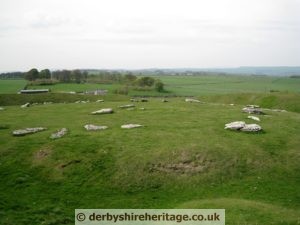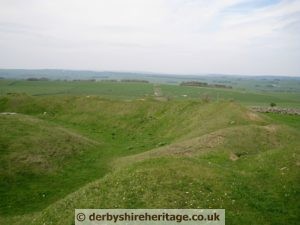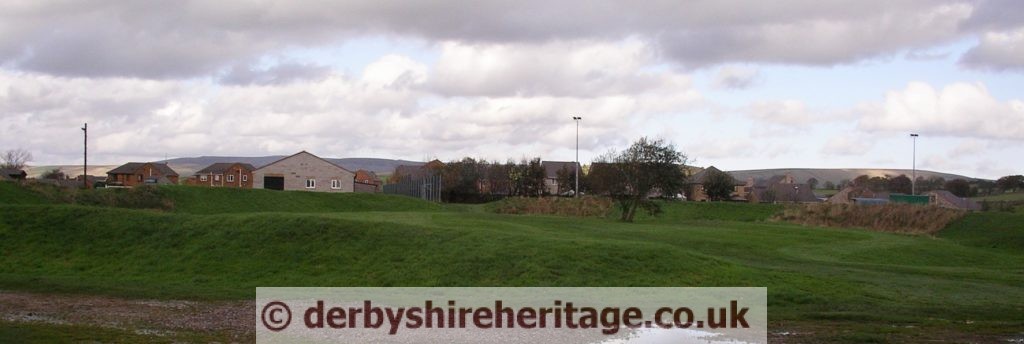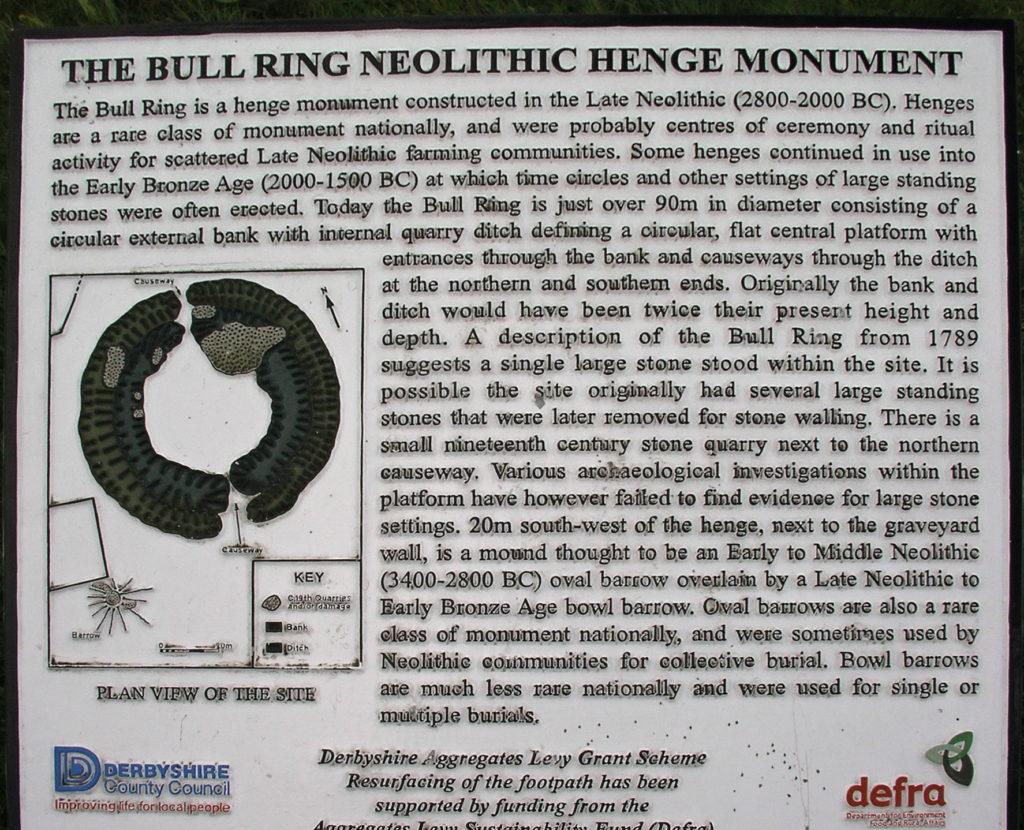Derbyshire Henges
ARBOR LOW – SK160635
Arbor Low is probably Derbyshire’s most important prehistoric site. This Stone Age monument was constructed approximately 500 years after the nearby Gib Hill Neolithic long barrow in around 2500BC and was probably developed over the next 500 years. Only two henges are known in the Peak District the other being the Bull Ring at Dove Holes and although their exact purpose is unknown it is speculated that they were the main communal focal points of their day. The people who built Arbor Low where pastoral farmers living in scattered groups but coming together seasonally.
The name Arbor Low is derived from the Anglo Saxon ‘Eorthburg Hlaw’ meaning ‘earthwork hill’ this name being given when the monument was already around 3500 years old.
In general Henges are ceremonial monuments often with stone or timber circles and other stone settings, built in the period 3000 to 2500 BC, with a circular bank with an internal ditch and thus could not have been built as defensive structures. The name henge derives from Stonehenge which does not fit with the recognised definition.

Arbor Low’s 8-10 metre wide bank with a diameter of a little less than 80 metres and height of 2 metres was designed to prevent the inside being visible before reaching the entrances. It is thought the bank may have been 3 metres high before erosion. The ditch, originally 2-3 metres deep before gradually filling up with silt, was dug into the rock with simple tools such as antler picks, ox bone shovels and wicker baskets to move material to the bank. It is thought to have taken several years with the work being carried out by many communities working during slacker times in their agricultural year.
In 1901-02 H St George Gray carried out the only excavation of the bank and ditch in modern times by cutting two trenches in the bank and six in the ditch.
The ditch was found to have steep rock-cut sides and an uneven base, findings included a few flint tools, weapons from flint production, antler tines and ox bones. There was also traces of fire and ledges forming steps into the ditch. A barbed and tanged Bronze Age arrowhead was found at the ditch base and higher up a Neolithic leaf shaped arrowhead. It has been suggested that the Bronze Age arrowhead dates the henge to this period but this is not necessarily true as excavations at other henges have shown that the ditches were periodically cleaned out and the banks refurbished, therefore the arrowhead may date to the last ditch cutting rather than the time of construction.

Two entrances not quite opposite each other break the bank and ditch, to the north west the widest one at 9 metres may have been the main entrance.
The interior of Arbor Low at 40 metres by 52 metres is flat with an impressive stone circle set near its edge made up of 50-52 large limestone slabs and broken fragments lying flat.
There has long been discussion as to whether the stones were ever standing but it is recorded that in 1785 a local man remembered that some of them were still standing. One stone is still not fully flat and there are seven vertically set stumps, one with its top lying adjacent. Other stones appear to be broken in such a way that they more than likely broke when they hit the ground. The stones consistently have one highly weathered face, occasionally with holes through indicating that they were quarried from the surface of the bedrock. It is also likely that they were transported to the site from another location as Gray noted that they were a different coloured limestone from that exposed during excavation of the ditch. Seven stones and parts of others have certainly been removed. Antiquarian plans show that this happened before the first detailed plan of the stones drawn up in 1785 and two fragments of stone were removed between 1785 and 1824.
The centre of the Arbor Low henge is where the cove was located for carrying out rituals which were hidden from view by large slabs.
On the bank near the higher entrance is a large round barrow 21 metres across and 2 metres high. This was excavated several times in 1770, 1782 and 1824 when very little was found (a human tooth, antler tines and animal bones). In May and June 1845 Thomas Bateman excavated it to find antler tines and deer bones and just south of the centre he found an undisturbed stone cist. The cist was polygonal with ten limestone side slabs and a massive cap stone. The interior was paved and found to contain burnt and scattered human bones , a bone pin, a flint, a lump of iron pyrites and a pottery fragment. At one end of the cist were two unusual pots. He also excavated a low barrow close by in 1844 when he dug into the centre and found a disturbed grave sunk into the rock below.
Bull Ring Henge at Dove Holes
The Bull Ring is a Class II henge near Dove Holes built in the late Neolithic period and is National Monument number 23282. About 20m away from the henge there are two barrows; one oval, one bowl.
The construction is a large, circular earthwork, about 1m high and 9-11m wide which was originally 2m high and 5.5-7m wide. There is a ditch on the inside varying between 0.5 to 1 metres deep and 8 to 12 metres wide; it was originally 1.2-2.1m deep and 5-6.5m wide. The ditch and bank are separated by a berm, which was originally 5m wide. There are entrances to the north and south, each of which have a causeway across the ditch. A skeleton was reputedly found near the north entrance; this entrance was also damaged in the 19th century by quarrying. The centre of the henge was ploughed in the 18th century; a drystone wall was also built across the site during the same era.
A single standing stone (orthostat) was recorded as remaining in 1789 by Pilkington, potentially the remnant of a stone circle. It has been suggested that stones from the henge were used as sleepers for the Peak Forest Tramway circa 1790.
 THE BULL RING NEOLITHIC HENGE MONUMENT information board states –
THE BULL RING NEOLITHIC HENGE MONUMENT information board states –
The Bull Ring is a henge monument constructed in the Late Neolithic (2800-2000 BC). Ranges are a rare class of monument nationally, and were probably centres of ceremony and ritual activity for scattered Late Neolithic farming communities. Some henges continued in use into the Early Bronze Age (2000-1500 BC) at which time circles and other settings of large standing stones were often erected. Today the Bull Ring is just over 90m in diameter consisting of a circular external bank with internal quarry ditch defining a circular, flat central platform with entrances through the bank and causeways through the ditch at the northern and southern ends. Originally the bank and ditch would have been twice their present height and depth. A description of the Bull Rug from 1789 suggests a single large stone stood within the site. It is possible the ,5,„te originally had several large standing stones that were later removed for stone walling. There is a small nineteenth century stone quarry next to the northern causeway. Various archaeological investigations within the platform have however fabled to find evidence for large stone settings. 20m south-west of the henge, next to the graveyard wall, is a mound thought to be an Early to Middle Neolithic (3400-2800 BC) oval barrow overlain by a Late Neolithic to Early Bronze Age bowl barrow. Oval barrows are also a rare class of monument nationally, and were sometimes used by Neolithic communities for collective burial. Bowl barrows are much less rare nationally and were used for single or multiple burials.


